Sorted by date Results 176 - 200 of 414

For a small group of Portland-area businessmen in 1929, opportunity was knocking - or so they thought. Jantzen Beach, the legendary swim-and-play amusement park on Hayden Island in the Columbia River, had opened in 1928 to vast sell-out crowds, and was doing very well there. It was backed by some deep pockets, and was a showplace for the Jantzen brand of swimwear. And the businessmen happened to own a large piece of real estate on the other side of the island - the easternmost tip of it, in...
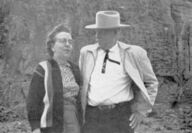
There was a time, and it was not too long ago, that the state of Oregon had something of a reputation as a place for great liars. Now, by "great liars," I mean tellers of the GOOD kind of lies, not the kind of lies various politicians are throwing around right now. I'm talking about the "Paul Bunyan, Casey Jones and Pecos Bill" kind of liars. One such "great liar" of honored memory is a lively Eastern Oregon fellow named Reub Long. You may recognize Reub's name if you've ever lived on the "dry...

When the moon is full and hanging low in the sky over Central Oregon, take a good close look at it. In one of its craters, surrounded by tire tracks and boot prints and the abandoned "moon buggy," a tiny chunk of Oregon lies on its surface. Here's how it got there: Starting around 1964, NASA started sending future lunar astronauts to various unusual places to study volcanic geology and to familiarize themselves with landscapes that they thought they might encounter on the moon. Although...

All through the summer of 1973, there was one song on the radio everywhere that you just couldn't get away from: Jim Croce's smash hit, "Bad, Bad Leroy Brown." Come to think of it, it's been very difficult to get away from that song ever since Croce wrote it. You probably are humming it to yourself right now: "Bad, bad Leroy Brown, baddest man in the whole damn town. Badder than old King Kong, meaner than a junkyard dog." The little Cascade-foothills town of Boring once had its own Bad, Bad...

On a calm day in mid-September of 1930, a small steam schooner put out of Crescent City, Calif., bound for Coos Bay with a crew of 18 men and a 250-ton load of logs. It was never seen again. The ship was the S.S. South Coast. On that day, three decades into the 20th century, she was already a historic vessel. In a sense, she actually predated the steam schooner era - in 1887, when her keel was laid, all steam schooners were actually sailing ships retrofitted with steam engines. The South Coast...

It was around 1878 that newly-single Mary Leonard moved to Portland and set herself up as the proprietress of a boardinghouse in the North End waterfront district - the seediest, roughest neighborhood in Portland. Mary was in her early 30s, striking in appearance and more than a little notorious. She'd moved there from The Dalles, where she had just been acquitted of charges of sneaking into her estranged husband's bedroom one night and shooting him in the head while he slept. She'd spent a full...
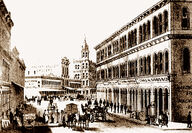
Most Oregon professional women can point to a truly amazing pioneer who opened her profession up to women. Physicans (physiciennes?) can look to Bethenia Owens-Adair, who, despite her now-embarrassing enthusiasm for eugenics, was a giant in her field. Journalists (journalistes?) have Abigail Scott Duniway, about whom little more needs to be said. But attorneys? Not so much - not, that is, if you believe the conventional wisdom on the subject. Oregon's first female attorney was a bit of an...
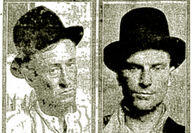
The sun had just gone down on a warm early-summer night, and the twilight was in the final stages of fading away when Union Pacific Railroad special agents Buck Phillips and H.G. Schneider stepped into the railroad yard to make the rounds. There had been some issues in the railyard. A gang of thieves had been systematically pillaging the railroad. Their M.O. was a simple one, and evidently pretty effective: they'd sneak aboard an outbound boxcar full of cigarettes and, while the train was en rou...

Sometime in 1915, a 40-year-old Black woman named Frankie Baker stepped off the train at Portland's Union Station. She had come to stay; Oregon would be her home for the rest of her life. At that time, Portland had a a reputation as a good place to hide out when you were on the lam. It was far off the beaten path; but the town had all the cultural perquisites of civilization, or most of them anyway. Plus, the people of Oregon had a reputation for minding their own business. So a lot of people wh...

By On February 20, 1931, a former Lincoln County commissioner named Elmer Calkins looked behind his tractor at the plow he was pulling and saw human bones strewn out along the furrow behind it. Calkins was working up a patch of land near the mouth of the Salmon River so that it could be flattened out into a smooth, park-like landscape for the summer camping resort he was building there. The new Roosevelt Highway - Highway 101 - was mostly built, and car-tripping tourists from the Willamette...
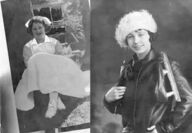
Annie-Sammy Oregon divorcee Agnes Anne “Annie” LeRoi arrived in Phoenix in the first few months of 1931 with her best friend and roommate, schoolteacher Hedvig “Sammy” Samuelson. They were climate refugees: Sammy had tuberculosis, and at the time the only cure for “consumption” was a dry climate and rest. Back then, many patients with TB waited until they were so far gone that the climate couldn’t save them; essentially, they moved to Arizona to die. Sammy wasn’t one of them; her case was mi...

It was the dark early-morning hours of Feb. 13, 1911, and off the north coast of Oregon the gasoline-powered motor schooner Oshkosh was in serious trouble. The Oshkosh was a coastwise cargo ship, but it wasn’t much bigger than a large yacht. It was 89 feet long and rated at just 145 tons. It was also nearly brand new, built in 1909 at the Kruse and Banks Shipyard in North Bend. The little freighter was only about a year and a half old. It would not see two. The Oshkosh had left Tillamook Bay a...
Santa Clara shipwreck By Finn J.D. John ON THE MORNING OF NOV. 5, 1915, at the back of the entrance to Coos Bay, a big steamship could be seen towering improbably over the beach, stuck fast in the sand close to shore. This was the Santa Clara, a 233-foot steamer on the Portland-San Francisco run. The Santa Clara didn’t much look like the scene of a humanitarian disaster, jutting out of the sand nearly plumb and level and nearly high and dry; but appearances were deceiving. Sixteen people died trying to get ashore when she first struck, three d...
Peter Iredale By Finn J.D. John In 2012, a big section of a Japanese harbor dock that had drifted across the Pacific Ocean was removed at considerable expense from the beach near Newport. The state government had gotten itself into something of a lather over the dock — as it also did several years ago with the wreckage of the freighter New Carissa. The government wanted that stuff off the beach immediately, if not sooner, and was willing to go to great lengths and spend lots of money to get it done. That hasn’t always been Oregon’s off...
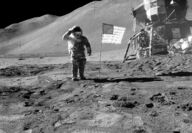
When the moon is full and hanging low in the sky over Central Oregon, take a good close look at it. In one of its craters, surrounded by tire tracks and boot prints and the abandoned "moon buggy," a tiny chunk of Oregon lies on its surface. Here's how it got there: Starting around 1964, NASA started sending future lunar astronauts to various unusual places to study volcanic geology and to familiarize themselves with landscapes that they thought they might encounter on the moon. Although...
Boxcar Bandits By Finn J.D. John The sun had just gone down on a warm early-summer night, and the twilight was in the final stages of fading away when Union Pacific Railroad special agents Buck Phillips and H.G. Schneider stepped into the railroad yard to make the rounds. There had been some issues in the railyard. A gang of thieves had been systematically pillaging the railroad. Their M.O. was a simple one, and evidently pretty effective: they’d sneak aboard an outbound boxcar full of cigarettes and, while the train was en route, start c...
Native Son cover By Finn J.D. John Continued From Last Week The curtain went up on Act Two about 15 years later, in downtown Portland. As with Act One, our sole source for the tale is an article published in the September 1900 issue of the magazine Oregon Native Son. The article’s author was Samuel L. Simpson, an Oregon poet, singer and raconteur who would have been more famous today had he not drunk himself to death in 1899 at age 54. According to this article, Simpson had just gone into the practice of law and opened an office in Portland i...
Stark St. Ferry By Finn J.D. John As the new day dawned on the first day of 1893, Customs Collector Jim Lotan would have told you, had you asked, that life was good. The previous year had been good to him. After years of working his way up through the ranks in the Republican Party, he’d found himself its state party leader after Senator Joe Simon went to Washington, D.C., to join the Republican National Committee. He’d reached that position just in time to blackmail the City of Portland, which had come cap in hand asking the Leg...
USCG type 36 By Finn J.D. John It was the worst disaster in the history of the U.S. Coast Guard in Oregon. Three rescue boats, including two of the legendary “unsinkable” motor lifeboats, went out to rescue someone — and none of them returned. Five “Coasties” died. And yet it all started as a routine rescue, late in the afternoon on Jan. 12, 1961. At a little after 4 p.m., a radio call came in to the Cape Disappointment Life Station, on the Washington side of the Columbia River entrance. Two Ilwaco men, brothers Bert and Stanley Bergman...
Click images to enlarge Cover (4.25"w X 8.5"h) '19 TG cover" src="http://mckenzieriverreflectionsnewspaper.com/sites/default/files/users/Ken%20Engelman/small_%2719%20TG%20cover.jpg" style="width: 89px; height: 180px; margin: 5px; float: left;" Page 2 (8.5"w X 8.5"h) Page 2 '19 TG" src="http://mckenzieriverreflectionsnewspaper.com/sites/default/files/small_%2719%20TG%20Page%202.jpg" style="width: 177px; height: 180px; margin: 5px; float: left;" Page 3 (17"w X 8.5"h) Page 3 TG Page 4 (4.25"w X 8.5"h) Page 4 Map (34"w X 16.5"h) TG map Back Cover...
Samson mine By Finn J.D. John It was the spring of 1862, and prospector William C. Aldred had been in the gold fields of California since the Gold Rush first broke out — about a dozen years. And he’d hit just enough gold to keep him fed, clothed, and hopeful. Then one day, as he was taking a little refreshment in the mining-camp saloon, a stranger blew in, took a few drinks on board, and started talking about the rich gold strike that had just been hit in Florence, Idaho. This fellow must have been a pretty talented talker, because A...
Striped Skunk By Finn J.D. John One of the most appealing things about life in rural Western Oregon, around the middle of the last century, was the wildlife. Loggers and mill workers in places like Valsetz and Wendling might not have gotten paid particularly well, but they worked and lived in a real “sportsman’s paradise”; the fishing, hunting, boating, and wilderness trekking opportunities were like a second paycheck. Sometimes, as in the case of loggers who ran trap lines on the side, it was a literal second paycheck. Sometimes, thoug...
Astoria street scene By Finn J.D. John Sometime around 1885 or 1886, a handsome-but-diffident-looking young man named Carroll Beebe got on a westbound train in southern Minnesota, on his way to new adventures in the young frontier state of Oregon. But the adventure he would find in the Beaver State wasn’t even close to what he had in mind as he stepped aboard that train. Carroll Beebe’s story is unusual because of its very usualness. Stories like it were so common in the 1880s that newspapers didn’t usually pick them up, and the people living t...
Whiskey war By Finn J.D. John The temperance movement, when it came to Portland in the early 1870s, really shouldn’t have taken anybody by surprise. What was surprising, though, was the form it took when it got there. Portland’s temperance drama reached a climax in April 1874 with a genuine knock-down-drag-out riot on the streets of downtown Portland, as angry citizens exchanged punches and clobbered each other with chairs — while, the whole time, serene as if they were singing in a forest glade, a cluster of upper-class ladies in the...
katonnka-bottle By Finn J.D. John There was a time, in the late 1800s, when one of the most popular medicines in the country was a product painstakingly brewed by members of the Warm Springs Indian tribe of Central Oregon, using natural ingredients harvested from the beautiful virgin forests and fruitful plains of their home hunting grounds. Or so the manufacturers of “KA-TON-KA, The Great Indian Medicine” would have their customers believe. “The ingredients of Ka-Ton-Ka are all gathered by the Warm Springs Indians in Oregon and Washi...